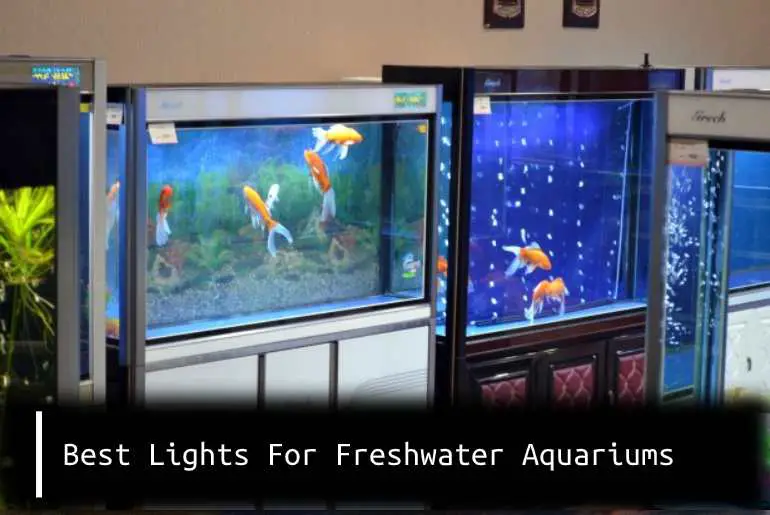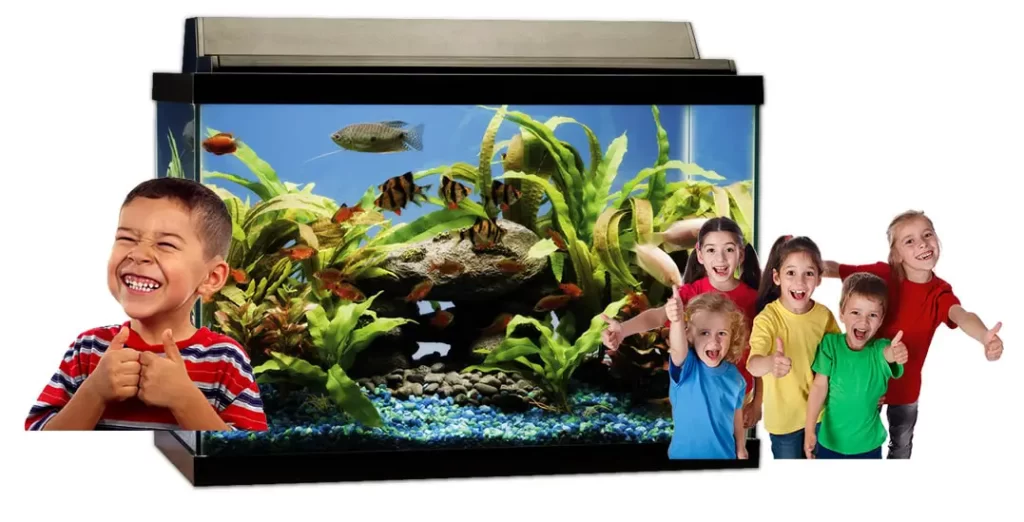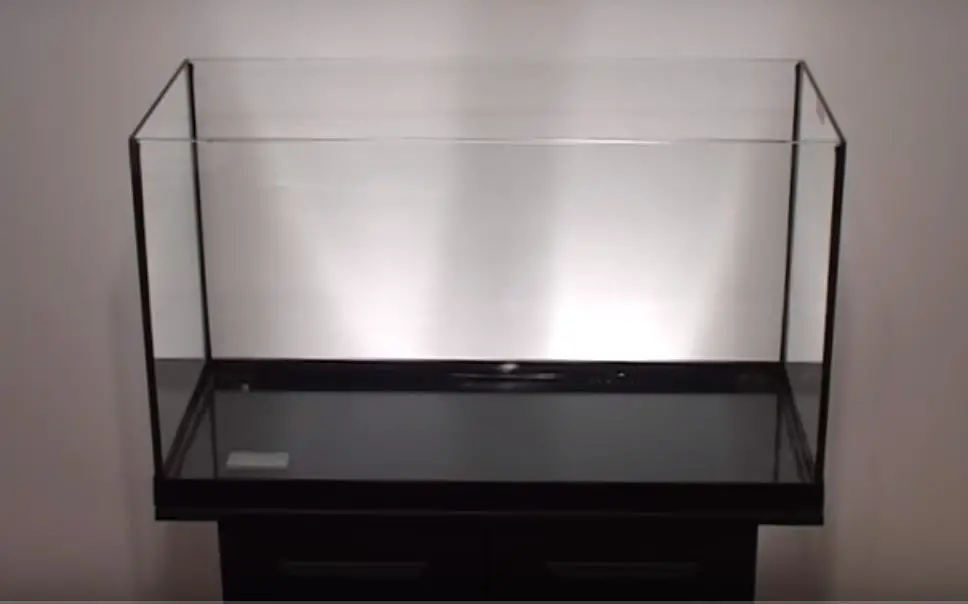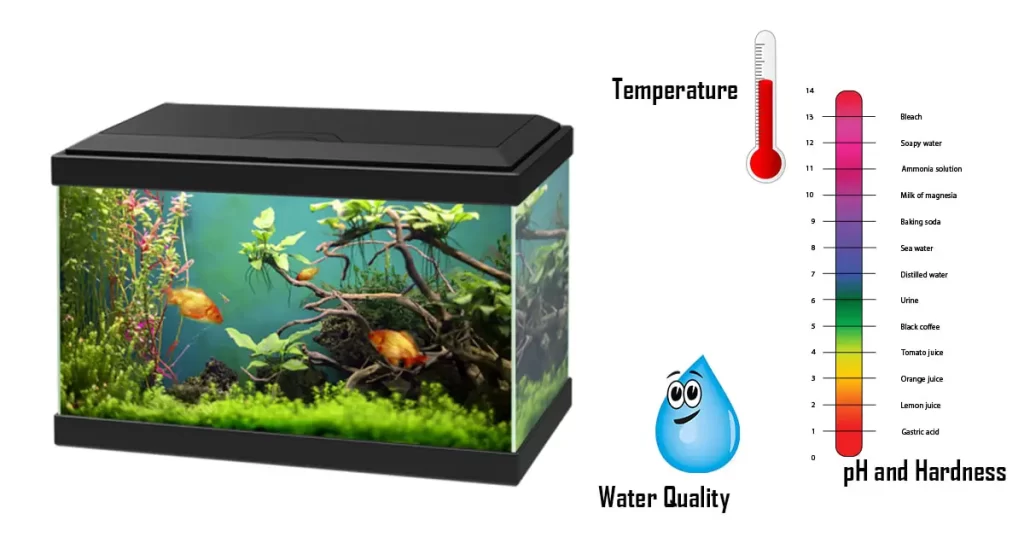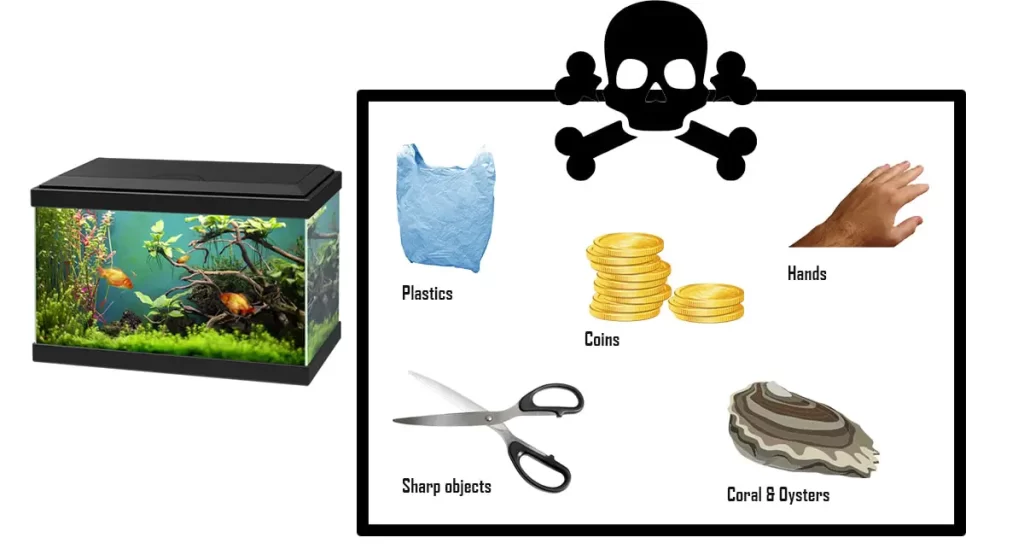It can be challenging to choose a lighting setup for your freshwater aquarium. But you can make a better choice if you are familiar with some of these fundamental words for aquarium lighting. What are the Best Lights For Freshwater Aquariums?
If you are brand-new to the aquarium hobby, the job of setting up and filling your first tank may easily overwhelm you. In addition to choosing the type and size of tank you desire, you also need to buy the necessary tools. Along with decorations, filters, and heaters, you should consider the kind of tank lighting you want to use. This is not a decision you should make lightly, but if you are unfamiliar with aquarium lighting, you might not know where to start.
If you are unsure of where to begin regarding your aquarium lighting, don’t worry; all you need to do becomes familiar with a few fundamental words so that you can compare items intelligently when making your choice. The better informed you are, the further likely you are to select the appropriate components for your tank.
An overview of key lighting parameters that you have to look after and a list of different lighting kinds can be found in this article. After reading this article, you will be well-equipped to select the ideal lighting setup for your aquarium.
LED Aquarium Lighting For Freshwater Aquariums
A better and healthier freshwater aquarium requires the proper illumination. For your tank, light-emitting diode (LED) illumination offers a number of benefits. There are several options available for this kind of illumination, giving you more possibilities than with conventional incandescent, fluorescent, or metal halide lights. However, you must make a sensible choice to make sure you obtain lights with the proper spectral range and brightness to sustain the vegetation in your tank and prevent the spread of algae.
LED Vs. Other Lighting Options
Standard fluorescent lighting, compact fluorescent lighting, metal halide lighting, and LED lighting are your best choices for freshwater aquarium lighting. Avoid using incandescent bulbs because they are only suitable for tiny aquariums and can produce excessive heat.
Standard fluorescent lights have a good light output and minimum heat production. Compact fluorescent bulbs, which produce more light while taking up less space, are frequently used in aquarium hoods. Due to their complete spectrum, metal halide lamps are better at simulating the tropical illumination that several freshwater fish experienced in their natural habitat and can support photosynthesis in aquarium plants. They can, however, produce a significant amount of heat.
LED lights, in comparison, operate significantly more coolly than conventional fluorescent and metal halide lighting. As long as you choose those with the correct output, they feature a variety of adjustable illumination colors and intensities and work well in both fish-only and planted tanks.
The Pros
To profit from the advantages of this sort of lighting, you could wish to install new LED lighting or upgrade the LED lighting on your current tank. These consist of the following:
Low Energy Requirements
LED lights require considerably less energy to operate. Compared to other aquarium lights, LED lighting is more energy-efficient. Within the first 12 to 18 months, your energy cost reductions will be enough to cover the difference in the price of an LED system.
Low Heat Output
Since LED lights don’t produce as much heat as incandescent and fluorescent bulbs do, they won’t raise the temperature of the water in your aquarium. To prevent the heat, they emit from shortening the LED chip’s lifespan. They still require sufficient air circulation. Thus, they should be kept from other hot lighting sources.
Long Life
The fact that LED lights endure so much longer than other conventional types of illumination is a highly well-liked benefit. Compared to incandescent bulbs, which last between four and twelve months, ordinary fluorescent bulbs, metal halide bulbs, which last between six and eighteen months, and compact fluorescent bulbs, which can last up to 28 months, LED lights have a lifespan of up to 50,000 hours or over six years. Although they are more expensive upfront, you will be saving the money you would spend on replacement bulbs for metal halide, T5, or compressed fluorescent bulbs over the course of five years.
Adjustable Light Intensity
This is especially beneficial for nocturnal fish because it allows for feeding and observing while simulating moonlight in the tank. Even LED lighting panels that mimic the lunar cycle every month exist. Using a remote or an app on your smartphone to change the lighting can be entertaining. Alternately, let your smart light source choose the appropriate colors and wavelengths based on the temperature and stage of plant growth.
The Drawbacks
Although LED aquarium decor has some drawbacks, there are some restrictions that must be taken into account.
Availability
A lot of aquarium kits with lights or hoods with lights do not include LED lights. The Eclipse systems, a popular combo device, are only available with regular fluorescent light bulbs. However, you can upgrade your Eclipse hoods with LED choices. Similarly, fluorescent lights are still available in some light fixtures.
Cost
LED fixtures are often a little more expensive to buy initially. Although you will ultimately compensate for this by saving energy as well as in the cost of replacing bulbs, your original budget might have to be higher.
Used For Planted Aquariums
The use of planted aquariums is a further major weakness. Only low to medium illumination needs are suitable for many LED light fixtures. That will work well for many plants as well as almost all fish. The ideal Kelvin ratings for the majority of planted aquariums are 6500K to 7000K. You must look for suitable LED lighting alternatives for plants with high light requirements, though.
New items are fast expanding the LED market. Most analysts concur that LEDs have a promising future.
How Should LED Aquarium Lighting Be Selected?
There are more factors involved in selecting the best aquarium light than just personal choice and price range. It has to do with the fish community in your tank as well as the setup you have there. When purchasing an aquarium light, remember that each tank setup has different illumination requirements.
For Planted Freshwater Tanks
Because live plants require adequate light for photosynthesis to take place, planted tanks tend to have more demanding lighting requirements. When purchasing a LED Light source for planted tanks, the proper type and adequate number are the two main considerations.
Color temp (Kelvin grade) is used to select the best kind of aquarium lighting. The greater the Kelvin value, the bluer the lighting is. The Kelvin value of light decreases as it becomes redder. Aquarium plants can tolerate a broad variety of color temperatures; however, for optimal plant development and aesthetics, the white spectrum from 5500 to 7500 K should be used.
The most effective unit for measuring is PAR (photosynthetic active radiation, measured in mol/m2/s). The PAR gauges how much sunlight is available for photosynthesis and plant development. You may use this dimension to decide whether a product can provide your planted tank with adequate light.
The optimal light must be intense enough to illuminate the tank and meet the photosynthetic requirements of your plants. To ensure that each plant receives precisely the right amount of light for its needs, you will need to install several light-demanding plants in various locations around your tank.
For A Tank With Just Freshwater Fish
less lighting is required in freshwater fish-only aquariums for you to view the fish and for the fish to look for food. The sort of light you select will mostly rely on the species of fish in your tank because different fish species have varying lighting requirements.
The majority of freshwater aquarium fish come from shallow streams with lush foliage above, where they typically get 10 to 12 hours of shady sunlight each day. The greatest reproduction of this type of light is a 5500–8000K aquarium light.
Some fish kept in aquariums are bashful, while others enjoy hiding. When purchasing the light, this needs to be taken into account. The fish may feel uncomfortable if the illumination is too strong. Multiple dark, hiding spots can be added to a tank with fish that both enjoy and dislike light to solve the problem and keep the shade-loving fish happy.
Top 7 Led Aquarium Lights For Freshwater Aquariums
The top 7 LED aquarium lights for freshwater tanks that are currently on the market have been compiled here. The LED lights that will best serve your freshwater tank’s demands are those that will do so in the end. As you review the list, keep in mind your personal aquarium’s goals and use those to inform your choices. Now let’s take a closer look at the top 8 freshwater aquarium lighting fixtures!
Current USA Satellite Freshwater Led Plus Pro Light Aquarium
One of the priciest aquarium light brands is the Current USA Satellite brand LED Lights. However, the features make the cost justified. The fixture, like most of the fixtures on this list, is relatively thin and rests discreetly on the surface of your tank.
A 24-hour cyclic light pattern is exposed to your tank with the Satellite Plus Pro’s 24-hour on/off cycle. Additionally, the light offers a wide range of color choices, allowing you to use the remote to change the amount of Colorful and white light in the aquarium.
Two personalized light settings can be stored on the remote for future convenience. The fixture also offers fascinating weather settings for cloudy days, moonlight, thunderstorms, and other conditions. Even if they could not be the most beneficial settings for your aquarium, they at least provide a colorful spectacle.
You can buy it here.
Four sizes are offered for the fixture:
- 18”-24”
- 24”-36”
- 36”-48”
- 48”-60”.
Pros
- highly adaptable.
- Extreme brightness.
- 24-hour cycle of light.
- Extra features for the weather simulation.
Cons
- can get pricey.
- Some consumers have experienced issues using a remote.
Finnex Planted+ 24/7 Fully Automated Aquarium LED
A thin, low-profile LED light, the Finnex Planted+ 24/7 Aquarium LED is incredibly small. Legs on the lamp allow you to firmly mount the device to your tank. The legs feature bolts to fit rimless Aquariums, a removable inner piece to go on somewhat bigger rimmed tanks, and are somewhat adjustable to suit smaller tanks. The fixture may sit right over your tank without a canopy because it has a water-resistant “splash guard” on it.
You can buy it here.
The light comes in five sizes:
- 20”
- 24”
- 30”
- 36”
- 48”
A schedule and remote control are both included in each gadget. The Finnex Planted+ 24/7’s name is derived in part from the timer (and its full automation). This fixture has a built-in timer that controls a “hands-free” simulated day/night cycle.
Pros
- 24/7 Day and Night Light Cycle.
- Light memory slots that can be customized.
- A high degree of customization Canopy is not necessary.
- Sufficient illumination.
- Great value is given to the features you receive.
Cons
- 24/7 cycle cannot be altered
- The 24/7 cycle was reportedly too bright for some users’ tanks.
- Some people complained about their remote control not working properly.
- Instead of being consolidated on one side, the wires are spread out on both sides of the light fixture.
LED Aquarium Light from NICREW with Extension Brackets
An affordable (compared to the market) white and blue LED light system is the NICREW LED Aquarium Light. The fixture is available in five sizes, with the smallest measuring 11″-19″ and the largest 46″-54″.
The adjustable metal brackets along either end of the LED fixture itself, which can be stretched and shortened, are what causes the variation in length. Avoid going above the fixture’s suggested length since, after a recommended 4″ extension on either side. The brackets might become unstable. The LED lighting itself is 11″ long in the instance of the 11″-19″ fixture, with the brackets not expanded. This is true of all available versions of this fixture. Therefore, bear that in mind when making your selection.
The NICREW has a white light setting and a blue light option, which is very bright. All of the LEDs in the fixtures are used in the white light mode, while only the blue LEDs are used in the blue light mode. Basic daytime and nightlight options are provided by these two modes, however, for some of you, it may be sufficient to meet your tank’s needs.
You can buy it here.
Pros
- Bright Cheap affordable lights.
- White/daylight and blue/nightlight are the two settings.
- Available in 5 sizes.
Cons
- no integrated timer.
- No cycles or other types of modification.
- Needs a glass canopy (or one made of clear plastic).
- When brackets are fully extended, there is a chance of a minor bend.
Finnex Fugeray Planted+ Aquarium Led Light
The elegant metal housing of the Finnex FugeRay Planted+ aquarium is thin. White LEDs, “true red” LEDs, and a number of blue LEDs are included in the fixture.
The manufacturer advertises the red LEDs in the FugeRay as “true red” 660nm bulbs. According to studies, this sort of bulb produces one of the most effective wavelengths for photosynthesis. The best way to determine what your tank responds to is to experiment on your own, but at the lowest level, the red LEDs will offer your aquarium a rudder, warmer color tone.
In contrast to the Planted+ 24/7 that we previously evaluated, the FugeRay does not come with a 24/7 cycle. It does contain blue lights (along with the “true red” LEDs we keep emphasizing) for the night light setting.
This fixture comes in seven sizes:
- 12”
- 16”
- 20”
- 24”
- 30”
- 36”
- 48”
Pros
- LED lights in “true red” for a cozier color and (perhaps) more effective photosynthesis.
- Favorable to plant growth.
- Slim case construction.
- Splash shield.
Cons
- Some users have experienced problems with lights flickering right out of the box or after a few months.
- The power supply has caused problems for certain users.
- No internal timer.
Ea Timer Fspec Led Aquarium Light By Beamswork
The customary sleek black case is included on the Beamswork EA FSPEC LED Fish tank Light. Seven sizes of the LED fixture are available:
- 18”
- 24”
- 30”
- 36”
- 48”
- 60”
- 72”
There’ll be brackets that you may extend to aid with the fit, so take notice that those specifications involve feet at their lowest extension setting. This fixture uses mostly white LED bulbs, but it also has blue, red, and green lights. There is a “full-spectrum” mode that makes use of every LED in the fixture. There is a “blue light” setting as well.
Although the optional timer module for the Beamswork EA Timer fixture is “pre-wired to be utilized with,” the owner should purchase it separately. The good news is that buying a timer separately shouldn’t significantly reduce your “fat stacks” because this light fixture is really affordable, even when contrasted to other affordable lights on the market.
You can buy it here.
Pros
- very affordable.
- Decent brightness.
- Attractive light tone.
- Smooth exterior.
Cons
- Secure mounting is lacking.
- Some variants of bigger fixtures bow in the middle.
- Although the timer is pre-wired, it is not included.
Marineland Led Aquarium Light
Although it isn’t the most stylish fixture available, the MarineLand LED Tank Lighting nonetheless does the job. Although it is more obvious than its thinner cousins, it is not offensive to the sight.
For this fixture, unlike the Finnex types we previously examined, there is no plastic splash protection. This suggests that you probably need a cover (glass is recommended by Marineland). If you have a Marineland hood and want to substitute the fixture that’s presently there, several users advise that somehow this fixture could fit in it.
This light is only available in one size, which is 11″. Although some users claim this light is suitable for tanks up to 40 gallons, the majority of users use it for tanks between 10 and 20 gallons. There are three options for this Marineland LED aquarium light: white light (“on”), blue light (“off”), and no light. Bright white light is present.
You can buy it here.
Pros
- Not too costly.
- Good, bright lighting.
- Excellent client care from Marineland.
Cons
- Some users claim that the switch is prone to breaking, especially when used often.
- There is no splash protection to prevent water damage.
- Beyond “white” and “blue,” there is no schedule and no way to change the color.
Aqua illumination Hydra Twentysix Hd
The newest development in the Hydra series is the Aquaillumination Hydra TwentySix HD.
The HD label is focused on the fixture’s capacity to utilize energy from LEDs (colors) that are not in use to increase the output of LEDs that are employed during the 24-hour lighting cycle. For a suitable mix of light distribution and focusing strength, the Hydra TwentySix HD employed 80-degree focusing lenses. At full power, the Hydra consumes 90 watts. The aquarium water remains cold thanks to the aluminum fixture housing’s effective role as a heat sink.
Brand-name LEDs from Cree, Osram, and SemiLED are used in the lighting. An external controller is not required for the Hydra fixtures. Through the myAI software, they may be manually set up or remotely operated by a computer or smart device.
You can buy it here.
Pros
- utilizes superior LEDs.
- wirelessly connects to a computer or smart device.
- It can be daisy-chained.
- No additional controller is required.
- The myAI app is simple and useful.
Cons
- Quite pricey in comparison to other brands.
- Need to be hung on brackets.
- The power supply is a distinct element that has to be covered up.
What Is The Best Light Schedule For A Freshwater Fish Tank?
The next step is to determine how to use the aquarium light to your advantage in addition to benefiting your plants and fish. The majority of freshwater plants and fish require 8 to 12 hours of white light every day. To ensure that your aquarium receives the same quantity of light during the same period of time each day, you should put your lighting system on a timer. It’s important to remember that the residents in your tank depend on the darkness just as much as they do the light.
The simplest method to get your aquarium’s balance just perfect is to try to mimic nature. There are aquarium lights with timers that ramp up and down gradually to simulate dawn and dusk. You may change the light intensity using these as it changes throughout the day. These alternatives are ideal for freshwater aquariums.
It’s also crucial to have a peaceful blue moonlight—created by a number of blue LEDs—and/or a time of darkness at night. To survive, both plants and fish need a healthy ratio of day and night. If the aquarium receives too much light, the plants may become scorched, the fish may become stressed, or algae growth may begin.
How Many Hours Of Illumination Do Plants In Aquariums Require?
The majority of aquarium plants require at least 8 hours of light each day to survive. However, with a 12-hour light cycle, the majority of aquarium plants will develop more quickly and robustly. The ideal light hours might change based on the light’s intensity and the particular needs of your plants. As there are numerous factors to take into account, it is recommended to experiment and modify the light cycle as necessary.
Remember that more light isn’t necessarily a good thing. For instance, if you provide excessive light, you can have too much algae development. This is particularly true if your vegetation is just getting started in the aquarium and is still young.
FAQ
Which Lighting Kind Is Ideal For Freshwater Aquariums?
Standard fluorescent lighting, compact fluorescent lighting, metal halide lighting, and LED lighting are your best alternatives for freshwater aquarium lighting. Avoid using incandescent bulbs since they are only appropriate for small tanks and can produce excessive heat.
The Ideal Hue Of Light For Freshwater Aquariums?
FULL RGB SPECTRUM.
It’s our go-to spectrum, and we STRONGLY advise using it for the majority of freshwater tanks. Nothing enriches your tank and brings out the vibrant hues like a complete, rich RGB (Red, Green, Blue) range of light. It doesn’t just make your fish’s colors pop; it also inhibits the formation of algae.
Are Blue Lights Required In Freshwater Aquariums?
The color spectrum that is least involved in photosynthesis and that our eyes respond to the best is green. For both marine and freshwater reef aquariums with plants, the blue wavelength is likely the most crucial component of the light spectrum.
Do Fish Feel Stress From Aquarium Lights?
Since aquarium fish don’t really require light, it is better to turn it off at night. As fish require a time of darkness to sleep, keeping the light on might stress them out. A dirty-looking tank will result from algae that grows too quickly under too much light. Do not end up leaving your lights on, is the quick response.
Conclusion
Knowing the fundamentals of planted aquarium lighting, you are aware that the solution is not straightforward. You must provide answers to the following questions for yourself:
- What are you attempting to achieve? Are you aiming to compete in an international aquascaping competition, cultivate your first aquarium plants, or sell plant seeds for a profit?
- What sort of vegetation do you wish to cultivate, and how much PAR do they need in terms of light intensity?
- What are the aquarium’s dimensions, and how numerous lights will you need to illuminate it?
- What is your spending limit, as well as which light will provide the most value?
There is nothing wrong with selecting a cost-effective lamp that works well for maintaining low-light plants when you are initially beginning to plant tanks. The more expensive choices, though, can be worthwhile to explore whether you have some money saved up. These higher-quality lights frequently have longer lifespans and are covered by manufacturers’ extended warranties. Intriguing aspects include the capacity to alter the color spectrum, reduce the intensity, and replicate the gradual dawns and sunsets observed in nature.

